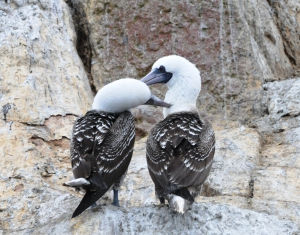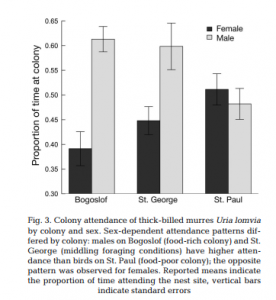Reading the Signs: Seabird sensitivity to environmental change and their potential as indicator species
By: Nicole Suren, SRC Intern
As climate change has had increasingly noticeable effects on the earth, scientists have developed more accurate and innovative ways to determine what these effects mean for the natural world. One of these methods is to use indicator species, species that can be used as proxies to diagnose the health of an ecosystem, to gauge how environments are changing and what can be done to mitigate these changes. Seabirds are emerging as the best indicator species in many marine environments, and their role in predicting environmental change and determining management strategies is becoming progressively more important as their sensitivity to environmental change is putting their populations at risk more than ever before.
Birds and Climate Change
Birds experience a wide variety of climate-dependent effects on their ecology and survival, which has made them popular subjects for ecological study. Some of the factors influenced by climate include metabolic rate, breeding success, and certain behaviors such as foraging and courtship behaviors, among many other things (Crick, 2004), and as climate change has gradually invoked large changes in bird habitats, birds have also experienced changes in distribution and phenology (periodic life cycle events such as migrations and breeding). Changes in phenology can include phenological miscuing, where the birds respond inappropriately to misleading environmental cues. For example, warmer weather can cause birds to arrive at breeding grounds early, although the conditions there may not yet be optimal. They can also experience phenological disjunction, where a species comes out of synch with its environment (Crick, 2004). Continuing with the previous example, the birds may experience phenological disjunction if their preferred prey is abundant when they usually arrive, but it is not yet abundant enough to sustain the breeding populations when they arrive at the wrong time.
Seabirds in Peril
Seabirds are especially sensitive to changes brought about by climate change, as they usually experience bottom-up effects caused by an unanticipated spatial or temporal mismatch with their prey (Grémillet & Boulinier, 2009). In other words, climate change can alter the location and/or timing of prey abundance, which adversely affects seabird populations. Seabirds in Antarctic ecosystems are also particularly vulnerable to habitat loss, as many species depend on ice cover for breeding success (Younger, Emmerson, & Miller, 2016). Seabirds have three options in responding to these challenges: 1) change their trophic status/foraging behavior, 2) change their distribution, or 3) go extinct (Grémillet & Boulinier, 2009). While options one and two are sometimes possible, they are restricted due to the memory effects and social constraints of seabird populations. Seabirds have been shown to use their memories of foraging in previous years to optimize foraging in the current year, which often results in high site fidelity. If the distribution of prey suddenly changes, this strategy becomes detrimental to foraging success.
Breeding colonies can also present a variety of climate-related challenges to seabirds. First, they have been recognized as centers of information for individual seabirds. Neighboring colonies will often have their own “cultures,” meaning that all the birds from one colony will usually use the same foraging grounds. If those foraging grounds no longer have abundant prey, then the social pressures to use those grounds will also be detrimental to foraging success. Additionally, there is high site fidelity in the colonies themselves because breeding colonies take a long time to establish (Grémillet & Boulinier, 2009). The combination of these factors can cause birds to fall into “ecological traps:” habitats that are low quality for reproduction and cannot sustain a population, but are chosen over higher quality habitats (Donovan & Thompson, 2001).
Seabirds as Indicator Species
Seabirds are ideal indicator species for marine environments for several reasons. First, they are highly visible in an environment where most other organisms are hidden underwater. Most species have large, easily locatable, land-based colonies where individuals can be captured and measured, as well as followed to sea to be studied (Piatt, Sydeman, & Browman, 2007). This ease of study in combination with their high sensitivity to environmental change makes them an obvious choice to represent the biological effects of climate change for many scientists. Declines in bird populations have accurately predicted fish stock collapses in the past, such as Peruvian booby population declines preceding the collapse of the Peruvian anchovetta.

Figure 1: Peruvian boobies, the species whose population declines helped predict the collapse of the Peruvian anchovetta. Image from Wikimedia Commons.
The challenge moving forward will be to define the parameters of seabird populations that can serve to predict other types of ecological effects. So far, studies have focused on seabirds as several types of indicators. They can serve as sentinel species, where levels of contaminants in the bodies of the birds represent environmental pollution. Predictive population models are also being used to predict the future of fish stocks, and different population parameters are being refined as indicators on different time scales. For example, population size can be used over several-yearlong to decadal scales, while annual breeding success can span monthly to one-year time periods (Piatt et al., 2007).
The potential for seabirds to be used as environmental indicators is just one more reason they are integral in the world’s ecosystems. In addition to being top predators, important prey items, and living connections between distant locations, they could now help humans control a problem that could cause damage to habitats globally, which is why scientists and managers are working together to effectively study and conserve these vitally important species around the world.
Work Cited:
Crick, H. Q. P. (2004). {The} impact of climate change on birds. Ibis, 146 {(Supp, 48–56. Retrieved from http://ftp.ibiologia.unam.mx/directorio/r/d_renton/pdf/5.pdf
Donovan, T., & Thompson, F. (2001). Modeling the ecological trap hypothesis: a habitat and demographic analysis for migrant songbirds. Ecological Applications, 11, 871–882.
Grémillet, D., & Boulinier, T. (2009). Spatial ecology and conservation of seabirds facing global climate change: A review. Marine Ecology Progress Series, 391(2), 121–137. https://doi.org/10.3354/meps08212
Piatt, J. F., Sydeman, W. J., & Browman, H. I. (2007). Seabirds as indicators of marine ecosystems. MARINE ECOLOGY PROGRESS SERIES Mar Ecol Prog Ser, 352, 199–204. https://doi.org/10.3354/meps07070
Younger, J. L., Emmerson, L. M., & Miller, K. J. (2016). The influence of historical climate changes on Southern Ocean marine predator populations: A comparative analysis. Global Change Biology. https://doi.org/10.1111/gcb.13104

